Evaluating the Trans-theoretical Model of Change for Obesity Control
VerifiedAdded on 2023/01/23
|12
|3267
|97
Essay
AI Summary
This essay provides an in-depth analysis of the trans-theoretical model of change, also known as the stages of change model, and its application in managing obesity. The assignment begins with an introduction to the model, developed by Prochaska and DiClemente, and its evolution from studies of smokers. The essay defines obesity, highlighting its health complications and the importance of lifestyle modifications. It then evaluates each stage of the model—pre-contemplation, contemplation, preparation, action, and maintenance—and how healthcare professionals can use the model to instill successful behavior change motivation. Key aspects like decisional balance and self-efficacy are also evaluated within the context of the model. The essay also discusses the processes of change and how healthcare professionals can implement them to help individuals move through the stages of change. This assignment provides a comprehensive understanding of the trans-theoretical model and its practical implications for obesity interventions.
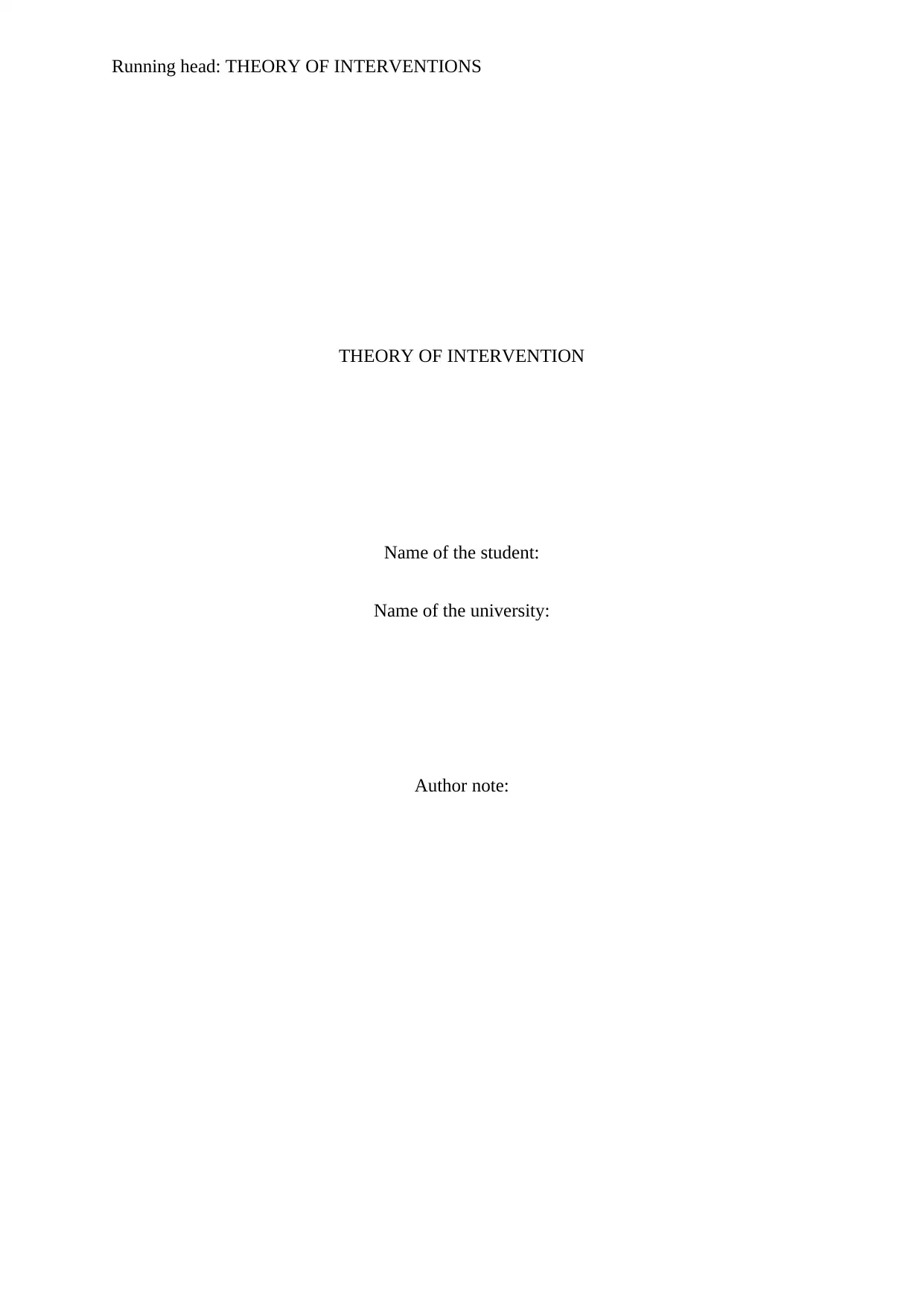
Running head: THEORY OF INTERVENTIONS
THEORY OF INTERVENTION
Name of the student:
Name of the university:
Author note:
THEORY OF INTERVENTION
Name of the student:
Name of the university:
Author note:
Paraphrase This Document
Need a fresh take? Get an instant paraphrase of this document with our AI Paraphraser
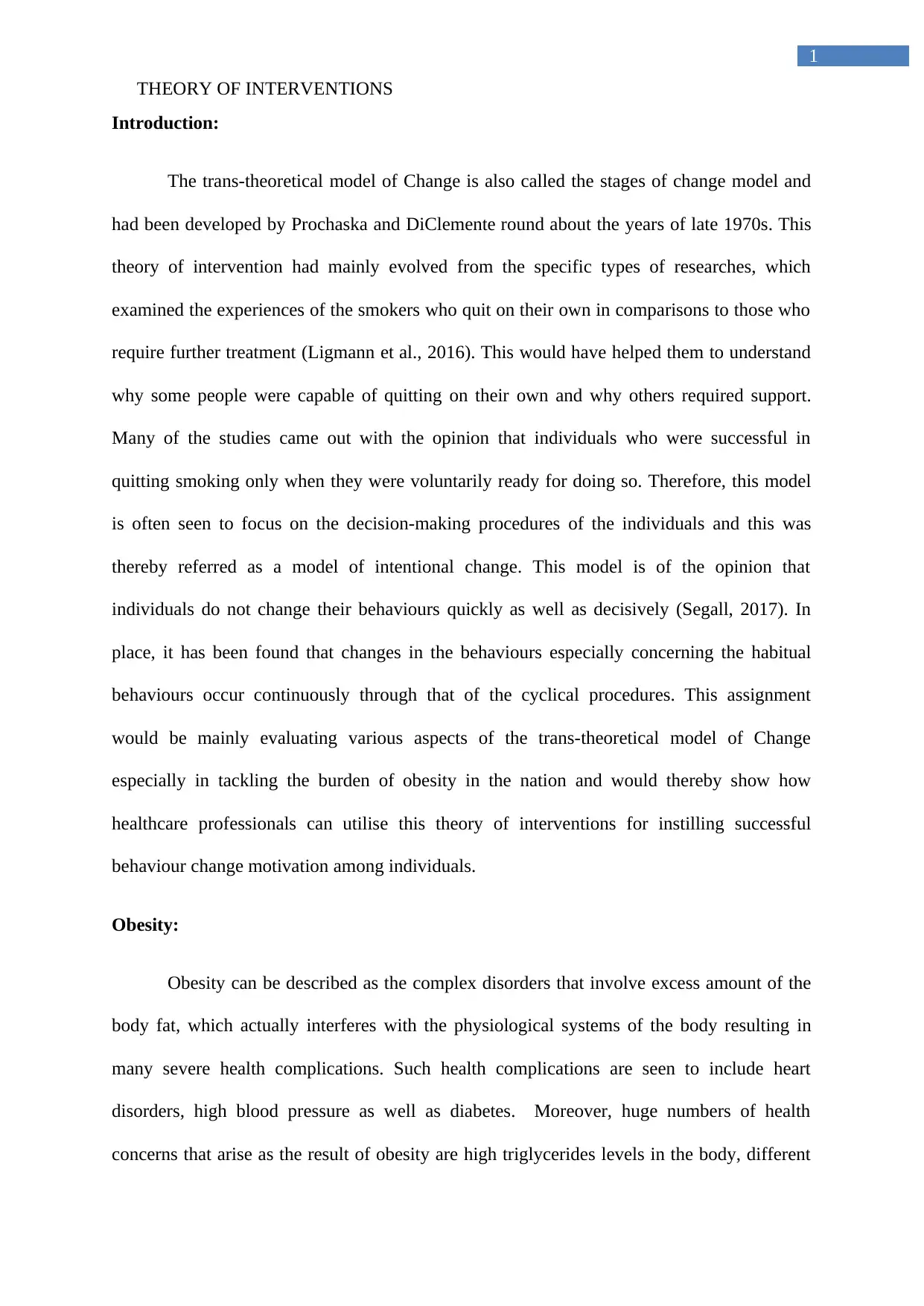
1
THEORY OF INTERVENTIONS
Introduction:
The trans-theoretical model of Change is also called the stages of change model and
had been developed by Prochaska and DiClemente round about the years of late 1970s. This
theory of intervention had mainly evolved from the specific types of researches, which
examined the experiences of the smokers who quit on their own in comparisons to those who
require further treatment (Ligmann et al., 2016). This would have helped them to understand
why some people were capable of quitting on their own and why others required support.
Many of the studies came out with the opinion that individuals who were successful in
quitting smoking only when they were voluntarily ready for doing so. Therefore, this model
is often seen to focus on the decision-making procedures of the individuals and this was
thereby referred as a model of intentional change. This model is of the opinion that
individuals do not change their behaviours quickly as well as decisively (Segall, 2017). In
place, it has been found that changes in the behaviours especially concerning the habitual
behaviours occur continuously through that of the cyclical procedures. This assignment
would be mainly evaluating various aspects of the trans-theoretical model of Change
especially in tackling the burden of obesity in the nation and would thereby show how
healthcare professionals can utilise this theory of interventions for instilling successful
behaviour change motivation among individuals.
Obesity:
Obesity can be described as the complex disorders that involve excess amount of the
body fat, which actually interferes with the physiological systems of the body resulting in
many severe health complications. Such health complications are seen to include heart
disorders, high blood pressure as well as diabetes. Moreover, huge numbers of health
concerns that arise as the result of obesity are high triglycerides levels in the body, different
THEORY OF INTERVENTIONS
Introduction:
The trans-theoretical model of Change is also called the stages of change model and
had been developed by Prochaska and DiClemente round about the years of late 1970s. This
theory of intervention had mainly evolved from the specific types of researches, which
examined the experiences of the smokers who quit on their own in comparisons to those who
require further treatment (Ligmann et al., 2016). This would have helped them to understand
why some people were capable of quitting on their own and why others required support.
Many of the studies came out with the opinion that individuals who were successful in
quitting smoking only when they were voluntarily ready for doing so. Therefore, this model
is often seen to focus on the decision-making procedures of the individuals and this was
thereby referred as a model of intentional change. This model is of the opinion that
individuals do not change their behaviours quickly as well as decisively (Segall, 2017). In
place, it has been found that changes in the behaviours especially concerning the habitual
behaviours occur continuously through that of the cyclical procedures. This assignment
would be mainly evaluating various aspects of the trans-theoretical model of Change
especially in tackling the burden of obesity in the nation and would thereby show how
healthcare professionals can utilise this theory of interventions for instilling successful
behaviour change motivation among individuals.
Obesity:
Obesity can be described as the complex disorders that involve excess amount of the
body fat, which actually interferes with the physiological systems of the body resulting in
many severe health complications. Such health complications are seen to include heart
disorders, high blood pressure as well as diabetes. Moreover, huge numbers of health
concerns that arise as the result of obesity are high triglycerides levels in the body, different
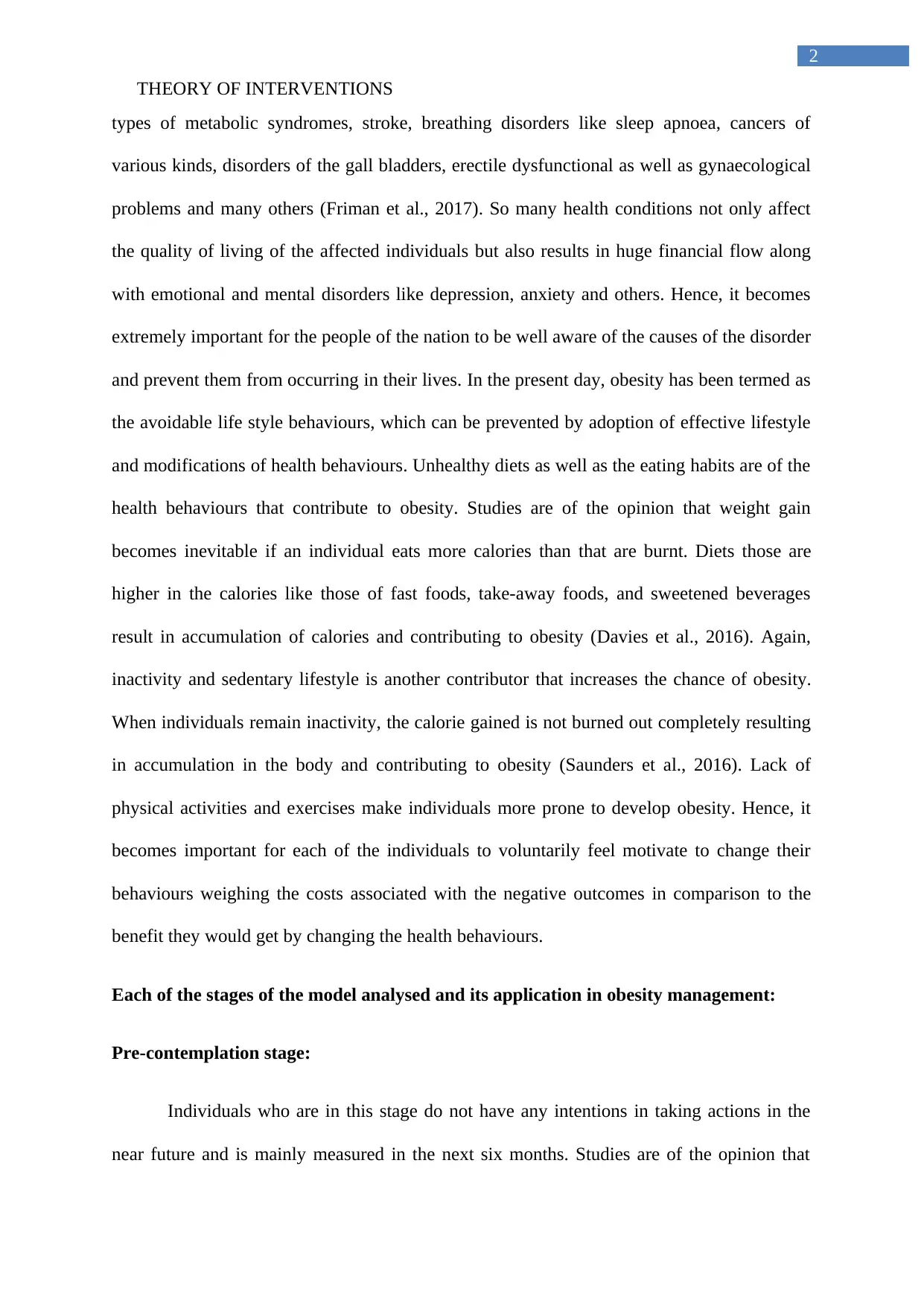
2
THEORY OF INTERVENTIONS
types of metabolic syndromes, stroke, breathing disorders like sleep apnoea, cancers of
various kinds, disorders of the gall bladders, erectile dysfunctional as well as gynaecological
problems and many others (Friman et al., 2017). So many health conditions not only affect
the quality of living of the affected individuals but also results in huge financial flow along
with emotional and mental disorders like depression, anxiety and others. Hence, it becomes
extremely important for the people of the nation to be well aware of the causes of the disorder
and prevent them from occurring in their lives. In the present day, obesity has been termed as
the avoidable life style behaviours, which can be prevented by adoption of effective lifestyle
and modifications of health behaviours. Unhealthy diets as well as the eating habits are of the
health behaviours that contribute to obesity. Studies are of the opinion that weight gain
becomes inevitable if an individual eats more calories than that are burnt. Diets those are
higher in the calories like those of fast foods, take-away foods, and sweetened beverages
result in accumulation of calories and contributing to obesity (Davies et al., 2016). Again,
inactivity and sedentary lifestyle is another contributor that increases the chance of obesity.
When individuals remain inactivity, the calorie gained is not burned out completely resulting
in accumulation in the body and contributing to obesity (Saunders et al., 2016). Lack of
physical activities and exercises make individuals more prone to develop obesity. Hence, it
becomes important for each of the individuals to voluntarily feel motivate to change their
behaviours weighing the costs associated with the negative outcomes in comparison to the
benefit they would get by changing the health behaviours.
Each of the stages of the model analysed and its application in obesity management:
Pre-contemplation stage:
Individuals who are in this stage do not have any intentions in taking actions in the
near future and is mainly measured in the next six months. Studies are of the opinion that
THEORY OF INTERVENTIONS
types of metabolic syndromes, stroke, breathing disorders like sleep apnoea, cancers of
various kinds, disorders of the gall bladders, erectile dysfunctional as well as gynaecological
problems and many others (Friman et al., 2017). So many health conditions not only affect
the quality of living of the affected individuals but also results in huge financial flow along
with emotional and mental disorders like depression, anxiety and others. Hence, it becomes
extremely important for the people of the nation to be well aware of the causes of the disorder
and prevent them from occurring in their lives. In the present day, obesity has been termed as
the avoidable life style behaviours, which can be prevented by adoption of effective lifestyle
and modifications of health behaviours. Unhealthy diets as well as the eating habits are of the
health behaviours that contribute to obesity. Studies are of the opinion that weight gain
becomes inevitable if an individual eats more calories than that are burnt. Diets those are
higher in the calories like those of fast foods, take-away foods, and sweetened beverages
result in accumulation of calories and contributing to obesity (Davies et al., 2016). Again,
inactivity and sedentary lifestyle is another contributor that increases the chance of obesity.
When individuals remain inactivity, the calorie gained is not burned out completely resulting
in accumulation in the body and contributing to obesity (Saunders et al., 2016). Lack of
physical activities and exercises make individuals more prone to develop obesity. Hence, it
becomes important for each of the individuals to voluntarily feel motivate to change their
behaviours weighing the costs associated with the negative outcomes in comparison to the
benefit they would get by changing the health behaviours.
Each of the stages of the model analysed and its application in obesity management:
Pre-contemplation stage:
Individuals who are in this stage do not have any intentions in taking actions in the
near future and is mainly measured in the next six months. Studies are of the opinion that
⊘ This is a preview!⊘
Do you want full access?
Subscribe today to unlock all pages.

Trusted by 1+ million students worldwide
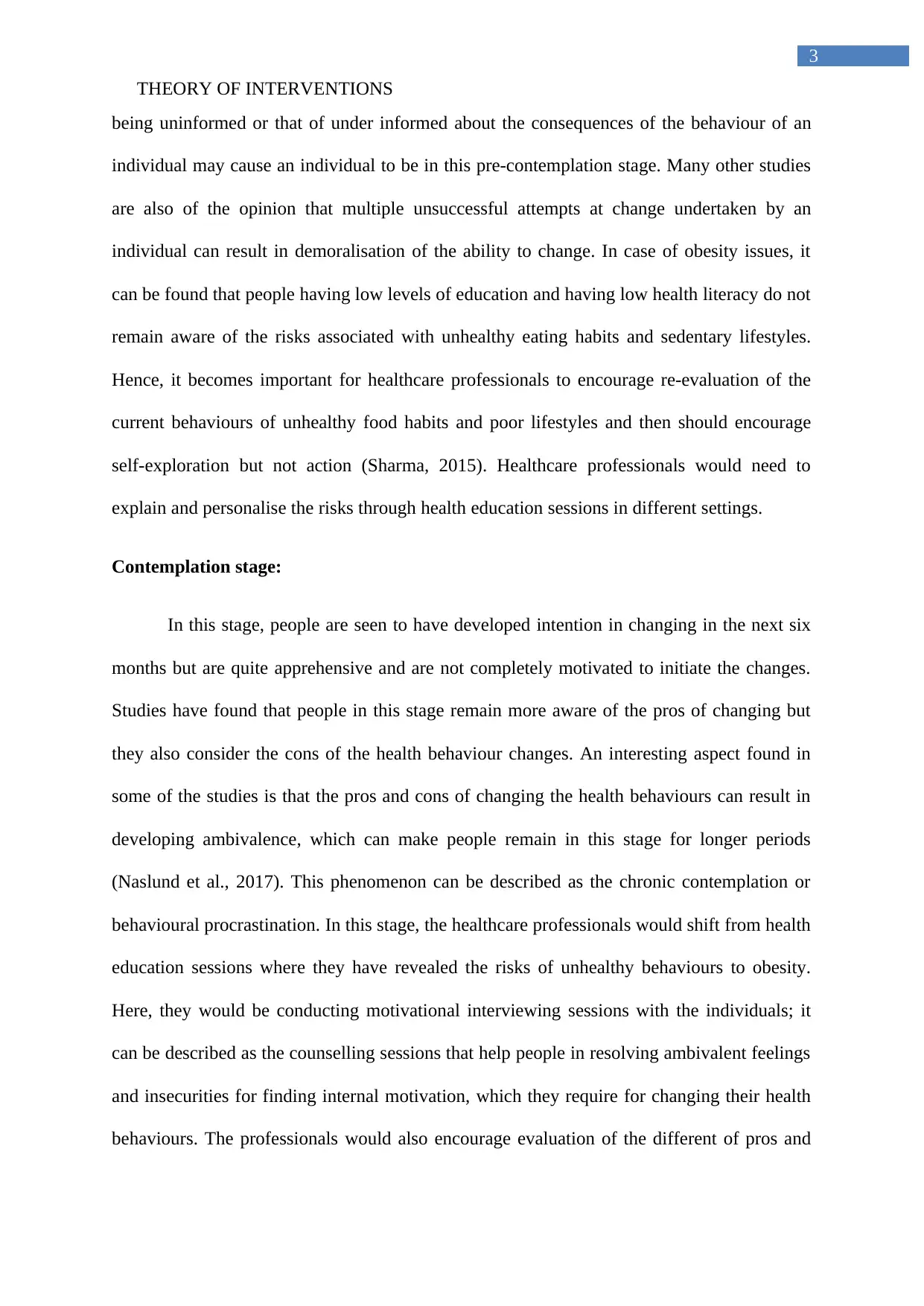
3
THEORY OF INTERVENTIONS
being uninformed or that of under informed about the consequences of the behaviour of an
individual may cause an individual to be in this pre-contemplation stage. Many other studies
are also of the opinion that multiple unsuccessful attempts at change undertaken by an
individual can result in demoralisation of the ability to change. In case of obesity issues, it
can be found that people having low levels of education and having low health literacy do not
remain aware of the risks associated with unhealthy eating habits and sedentary lifestyles.
Hence, it becomes important for healthcare professionals to encourage re-evaluation of the
current behaviours of unhealthy food habits and poor lifestyles and then should encourage
self-exploration but not action (Sharma, 2015). Healthcare professionals would need to
explain and personalise the risks through health education sessions in different settings.
Contemplation stage:
In this stage, people are seen to have developed intention in changing in the next six
months but are quite apprehensive and are not completely motivated to initiate the changes.
Studies have found that people in this stage remain more aware of the pros of changing but
they also consider the cons of the health behaviour changes. An interesting aspect found in
some of the studies is that the pros and cons of changing the health behaviours can result in
developing ambivalence, which can make people remain in this stage for longer periods
(Naslund et al., 2017). This phenomenon can be described as the chronic contemplation or
behavioural procrastination. In this stage, the healthcare professionals would shift from health
education sessions where they have revealed the risks of unhealthy behaviours to obesity.
Here, they would be conducting motivational interviewing sessions with the individuals; it
can be described as the counselling sessions that help people in resolving ambivalent feelings
and insecurities for finding internal motivation, which they require for changing their health
behaviours. The professionals would also encourage evaluation of the different of pros and
THEORY OF INTERVENTIONS
being uninformed or that of under informed about the consequences of the behaviour of an
individual may cause an individual to be in this pre-contemplation stage. Many other studies
are also of the opinion that multiple unsuccessful attempts at change undertaken by an
individual can result in demoralisation of the ability to change. In case of obesity issues, it
can be found that people having low levels of education and having low health literacy do not
remain aware of the risks associated with unhealthy eating habits and sedentary lifestyles.
Hence, it becomes important for healthcare professionals to encourage re-evaluation of the
current behaviours of unhealthy food habits and poor lifestyles and then should encourage
self-exploration but not action (Sharma, 2015). Healthcare professionals would need to
explain and personalise the risks through health education sessions in different settings.
Contemplation stage:
In this stage, people are seen to have developed intention in changing in the next six
months but are quite apprehensive and are not completely motivated to initiate the changes.
Studies have found that people in this stage remain more aware of the pros of changing but
they also consider the cons of the health behaviour changes. An interesting aspect found in
some of the studies is that the pros and cons of changing the health behaviours can result in
developing ambivalence, which can make people remain in this stage for longer periods
(Naslund et al., 2017). This phenomenon can be described as the chronic contemplation or
behavioural procrastination. In this stage, the healthcare professionals would shift from health
education sessions where they have revealed the risks of unhealthy behaviours to obesity.
Here, they would be conducting motivational interviewing sessions with the individuals; it
can be described as the counselling sessions that help people in resolving ambivalent feelings
and insecurities for finding internal motivation, which they require for changing their health
behaviours. The professionals would also encourage evaluation of the different of pros and
Paraphrase This Document
Need a fresh take? Get an instant paraphrase of this document with our AI Paraphraser
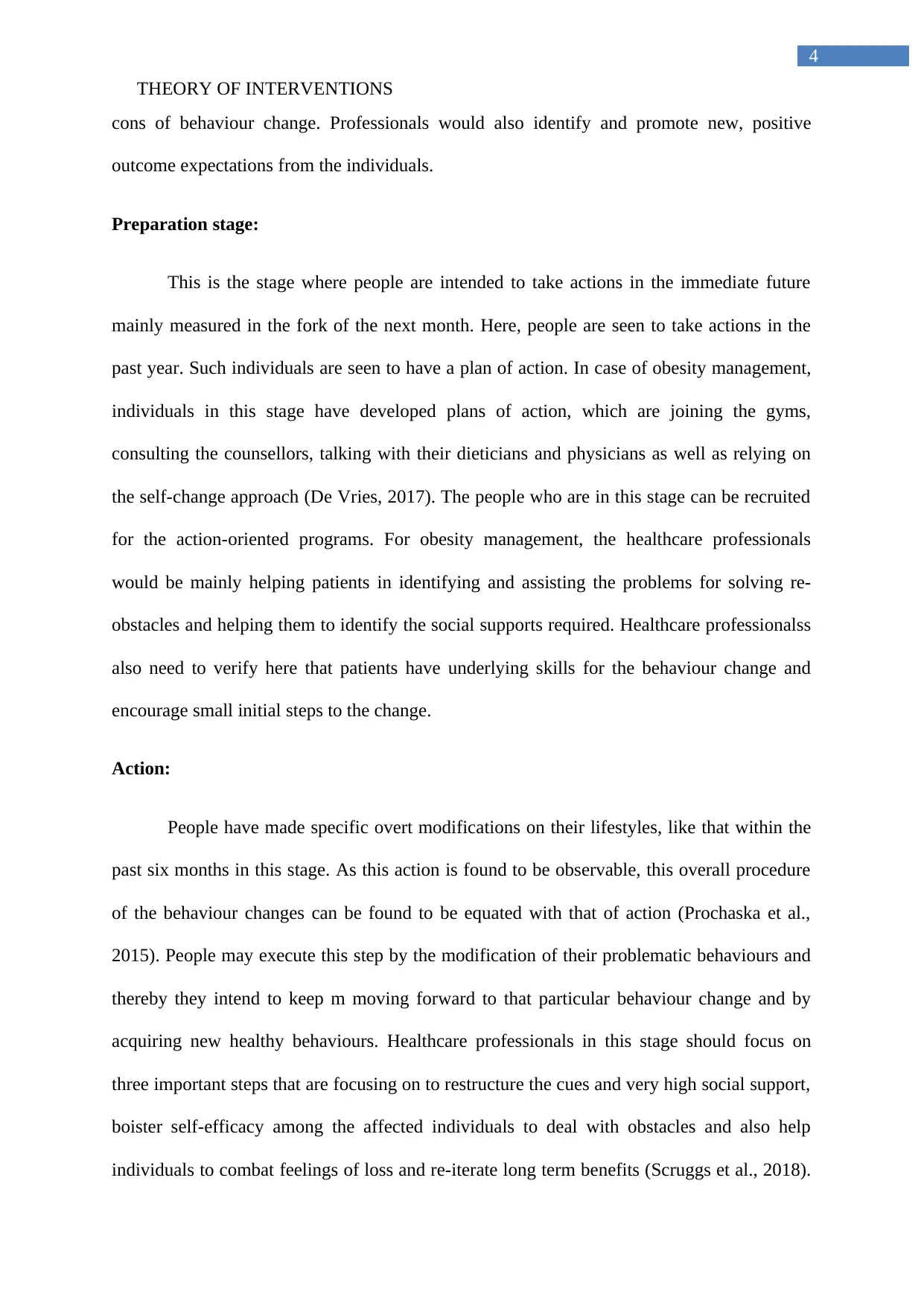
4
THEORY OF INTERVENTIONS
cons of behaviour change. Professionals would also identify and promote new, positive
outcome expectations from the individuals.
Preparation stage:
This is the stage where people are intended to take actions in the immediate future
mainly measured in the fork of the next month. Here, people are seen to take actions in the
past year. Such individuals are seen to have a plan of action. In case of obesity management,
individuals in this stage have developed plans of action, which are joining the gyms,
consulting the counsellors, talking with their dieticians and physicians as well as relying on
the self-change approach (De Vries, 2017). The people who are in this stage can be recruited
for the action-oriented programs. For obesity management, the healthcare professionals
would be mainly helping patients in identifying and assisting the problems for solving re-
obstacles and helping them to identify the social supports required. Healthcare professionalss
also need to verify here that patients have underlying skills for the behaviour change and
encourage small initial steps to the change.
Action:
People have made specific overt modifications on their lifestyles, like that within the
past six months in this stage. As this action is found to be observable, this overall procedure
of the behaviour changes can be found to be equated with that of action (Prochaska et al.,
2015). People may execute this step by the modification of their problematic behaviours and
thereby they intend to keep m moving forward to that particular behaviour change and by
acquiring new healthy behaviours. Healthcare professionals in this stage should focus on
three important steps that are focusing on to restructure the cues and very high social support,
boister self-efficacy among the affected individuals to deal with obstacles and also help
individuals to combat feelings of loss and re-iterate long term benefits (Scruggs et al., 2018).
THEORY OF INTERVENTIONS
cons of behaviour change. Professionals would also identify and promote new, positive
outcome expectations from the individuals.
Preparation stage:
This is the stage where people are intended to take actions in the immediate future
mainly measured in the fork of the next month. Here, people are seen to take actions in the
past year. Such individuals are seen to have a plan of action. In case of obesity management,
individuals in this stage have developed plans of action, which are joining the gyms,
consulting the counsellors, talking with their dieticians and physicians as well as relying on
the self-change approach (De Vries, 2017). The people who are in this stage can be recruited
for the action-oriented programs. For obesity management, the healthcare professionals
would be mainly helping patients in identifying and assisting the problems for solving re-
obstacles and helping them to identify the social supports required. Healthcare professionalss
also need to verify here that patients have underlying skills for the behaviour change and
encourage small initial steps to the change.
Action:
People have made specific overt modifications on their lifestyles, like that within the
past six months in this stage. As this action is found to be observable, this overall procedure
of the behaviour changes can be found to be equated with that of action (Prochaska et al.,
2015). People may execute this step by the modification of their problematic behaviours and
thereby they intend to keep m moving forward to that particular behaviour change and by
acquiring new healthy behaviours. Healthcare professionals in this stage should focus on
three important steps that are focusing on to restructure the cues and very high social support,
boister self-efficacy among the affected individuals to deal with obstacles and also help
individuals to combat feelings of loss and re-iterate long term benefits (Scruggs et al., 2018).
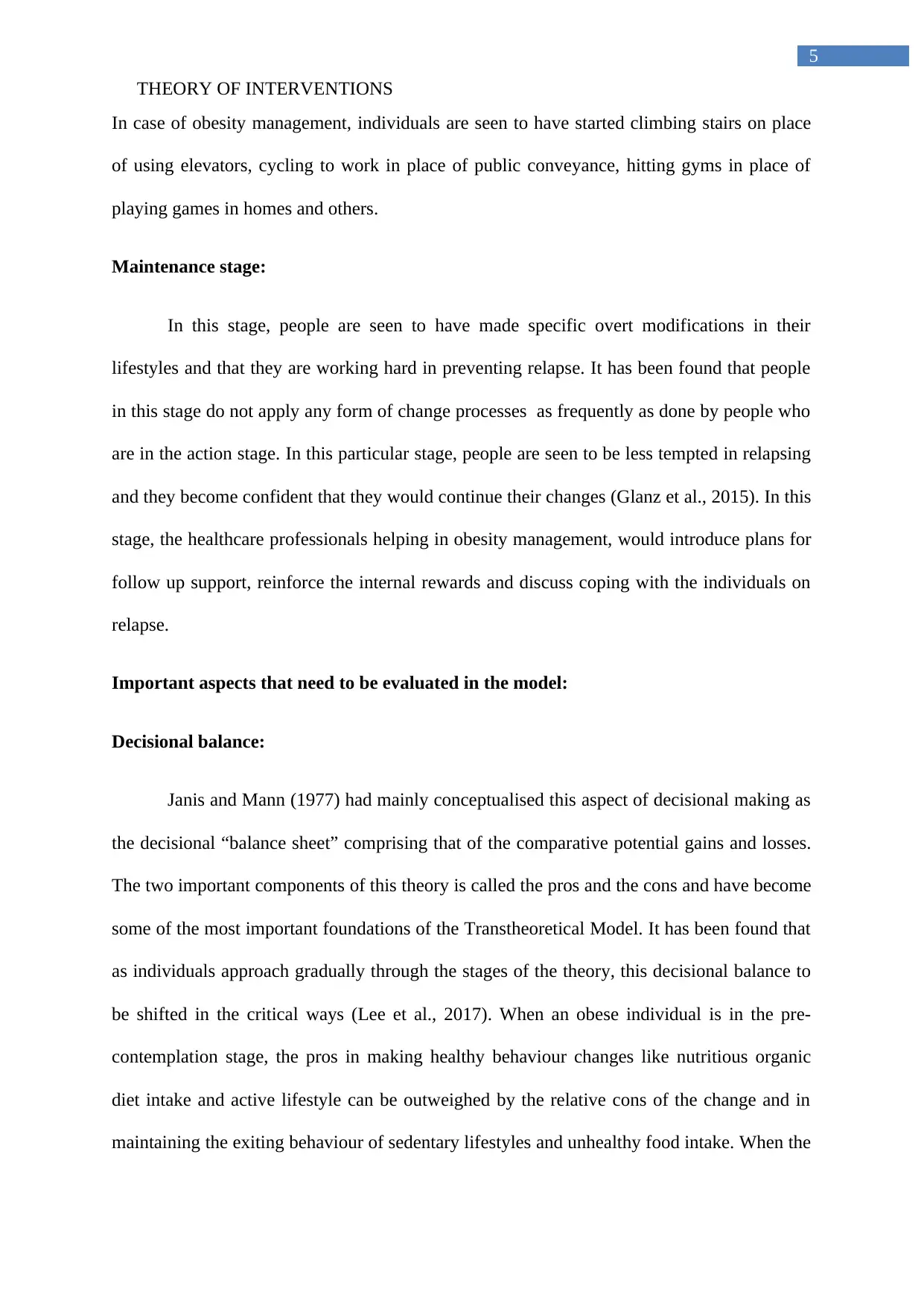
5
THEORY OF INTERVENTIONS
In case of obesity management, individuals are seen to have started climbing stairs on place
of using elevators, cycling to work in place of public conveyance, hitting gyms in place of
playing games in homes and others.
Maintenance stage:
In this stage, people are seen to have made specific overt modifications in their
lifestyles and that they are working hard in preventing relapse. It has been found that people
in this stage do not apply any form of change processes as frequently as done by people who
are in the action stage. In this particular stage, people are seen to be less tempted in relapsing
and they become confident that they would continue their changes (Glanz et al., 2015). In this
stage, the healthcare professionals helping in obesity management, would introduce plans for
follow up support, reinforce the internal rewards and discuss coping with the individuals on
relapse.
Important aspects that need to be evaluated in the model:
Decisional balance:
Janis and Mann (1977) had mainly conceptualised this aspect of decisional making as
the decisional “balance sheet” comprising that of the comparative potential gains and losses.
The two important components of this theory is called the pros and the cons and have become
some of the most important foundations of the Transtheoretical Model. It has been found that
as individuals approach gradually through the stages of the theory, this decisional balance to
be shifted in the critical ways (Lee et al., 2017). When an obese individual is in the pre-
contemplation stage, the pros in making healthy behaviour changes like nutritious organic
diet intake and active lifestyle can be outweighed by the relative cons of the change and in
maintaining the exiting behaviour of sedentary lifestyles and unhealthy food intake. When the
THEORY OF INTERVENTIONS
In case of obesity management, individuals are seen to have started climbing stairs on place
of using elevators, cycling to work in place of public conveyance, hitting gyms in place of
playing games in homes and others.
Maintenance stage:
In this stage, people are seen to have made specific overt modifications in their
lifestyles and that they are working hard in preventing relapse. It has been found that people
in this stage do not apply any form of change processes as frequently as done by people who
are in the action stage. In this particular stage, people are seen to be less tempted in relapsing
and they become confident that they would continue their changes (Glanz et al., 2015). In this
stage, the healthcare professionals helping in obesity management, would introduce plans for
follow up support, reinforce the internal rewards and discuss coping with the individuals on
relapse.
Important aspects that need to be evaluated in the model:
Decisional balance:
Janis and Mann (1977) had mainly conceptualised this aspect of decisional making as
the decisional “balance sheet” comprising that of the comparative potential gains and losses.
The two important components of this theory is called the pros and the cons and have become
some of the most important foundations of the Transtheoretical Model. It has been found that
as individuals approach gradually through the stages of the theory, this decisional balance to
be shifted in the critical ways (Lee et al., 2017). When an obese individual is in the pre-
contemplation stage, the pros in making healthy behaviour changes like nutritious organic
diet intake and active lifestyle can be outweighed by the relative cons of the change and in
maintaining the exiting behaviour of sedentary lifestyles and unhealthy food intake. When the
⊘ This is a preview!⊘
Do you want full access?
Subscribe today to unlock all pages.

Trusted by 1+ million students worldwide
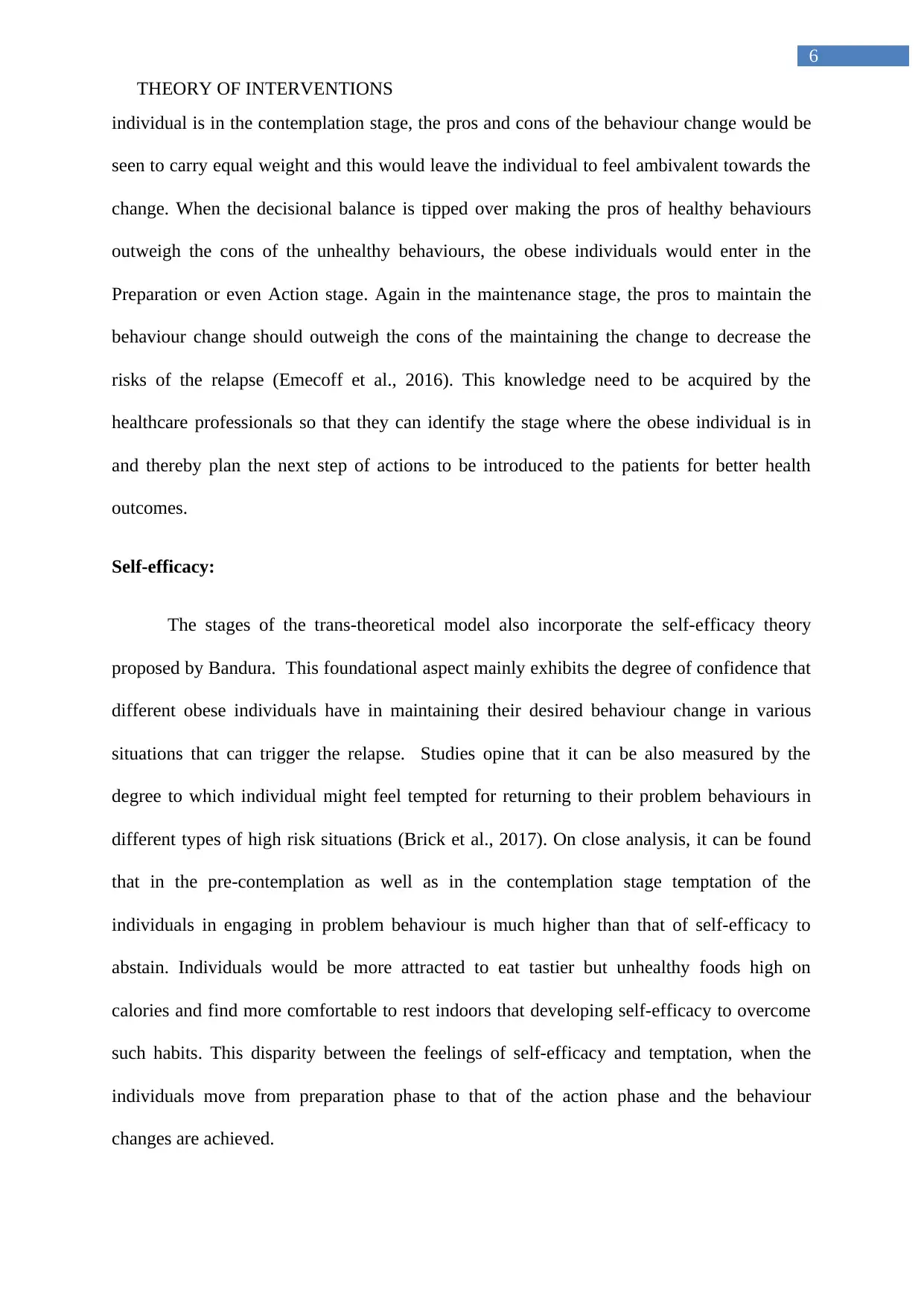
6
THEORY OF INTERVENTIONS
individual is in the contemplation stage, the pros and cons of the behaviour change would be
seen to carry equal weight and this would leave the individual to feel ambivalent towards the
change. When the decisional balance is tipped over making the pros of healthy behaviours
outweigh the cons of the unhealthy behaviours, the obese individuals would enter in the
Preparation or even Action stage. Again in the maintenance stage, the pros to maintain the
behaviour change should outweigh the cons of the maintaining the change to decrease the
risks of the relapse (Emecoff et al., 2016). This knowledge need to be acquired by the
healthcare professionals so that they can identify the stage where the obese individual is in
and thereby plan the next step of actions to be introduced to the patients for better health
outcomes.
Self-efficacy:
The stages of the trans-theoretical model also incorporate the self-efficacy theory
proposed by Bandura. This foundational aspect mainly exhibits the degree of confidence that
different obese individuals have in maintaining their desired behaviour change in various
situations that can trigger the relapse. Studies opine that it can be also measured by the
degree to which individual might feel tempted for returning to their problem behaviours in
different types of high risk situations (Brick et al., 2017). On close analysis, it can be found
that in the pre-contemplation as well as in the contemplation stage temptation of the
individuals in engaging in problem behaviour is much higher than that of self-efficacy to
abstain. Individuals would be more attracted to eat tastier but unhealthy foods high on
calories and find more comfortable to rest indoors that developing self-efficacy to overcome
such habits. This disparity between the feelings of self-efficacy and temptation, when the
individuals move from preparation phase to that of the action phase and the behaviour
changes are achieved.
THEORY OF INTERVENTIONS
individual is in the contemplation stage, the pros and cons of the behaviour change would be
seen to carry equal weight and this would leave the individual to feel ambivalent towards the
change. When the decisional balance is tipped over making the pros of healthy behaviours
outweigh the cons of the unhealthy behaviours, the obese individuals would enter in the
Preparation or even Action stage. Again in the maintenance stage, the pros to maintain the
behaviour change should outweigh the cons of the maintaining the change to decrease the
risks of the relapse (Emecoff et al., 2016). This knowledge need to be acquired by the
healthcare professionals so that they can identify the stage where the obese individual is in
and thereby plan the next step of actions to be introduced to the patients for better health
outcomes.
Self-efficacy:
The stages of the trans-theoretical model also incorporate the self-efficacy theory
proposed by Bandura. This foundational aspect mainly exhibits the degree of confidence that
different obese individuals have in maintaining their desired behaviour change in various
situations that can trigger the relapse. Studies opine that it can be also measured by the
degree to which individual might feel tempted for returning to their problem behaviours in
different types of high risk situations (Brick et al., 2017). On close analysis, it can be found
that in the pre-contemplation as well as in the contemplation stage temptation of the
individuals in engaging in problem behaviour is much higher than that of self-efficacy to
abstain. Individuals would be more attracted to eat tastier but unhealthy foods high on
calories and find more comfortable to rest indoors that developing self-efficacy to overcome
such habits. This disparity between the feelings of self-efficacy and temptation, when the
individuals move from preparation phase to that of the action phase and the behaviour
changes are achieved.
Paraphrase This Document
Need a fresh take? Get an instant paraphrase of this document with our AI Paraphraser
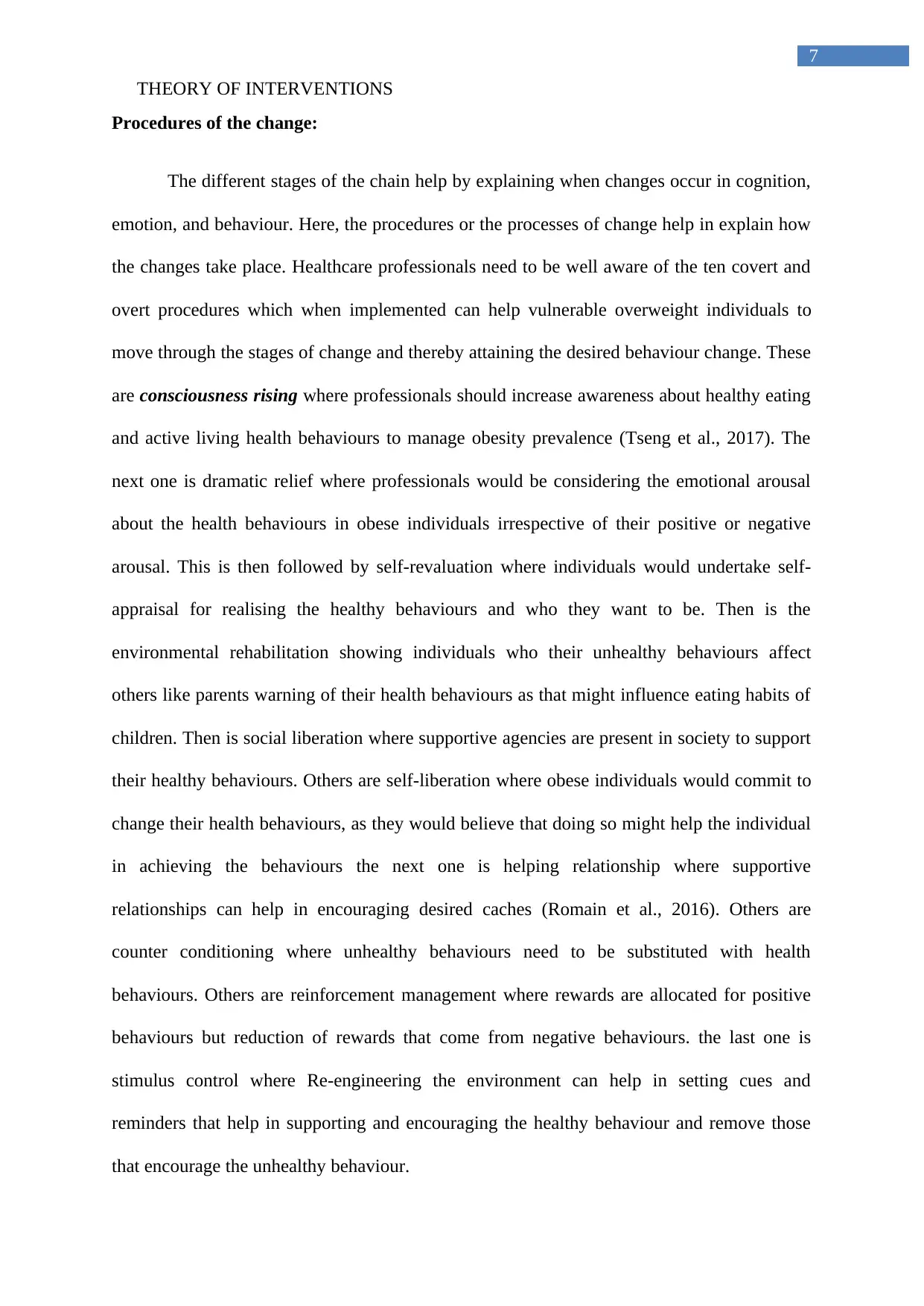
7
THEORY OF INTERVENTIONS
Procedures of the change:
The different stages of the chain help by explaining when changes occur in cognition,
emotion, and behaviour. Here, the procedures or the processes of change help in explain how
the changes take place. Healthcare professionals need to be well aware of the ten covert and
overt procedures which when implemented can help vulnerable overweight individuals to
move through the stages of change and thereby attaining the desired behaviour change. These
are consciousness rising where professionals should increase awareness about healthy eating
and active living health behaviours to manage obesity prevalence (Tseng et al., 2017). The
next one is dramatic relief where professionals would be considering the emotional arousal
about the health behaviours in obese individuals irrespective of their positive or negative
arousal. This is then followed by self-revaluation where individuals would undertake self-
appraisal for realising the healthy behaviours and who they want to be. Then is the
environmental rehabilitation showing individuals who their unhealthy behaviours affect
others like parents warning of their health behaviours as that might influence eating habits of
children. Then is social liberation where supportive agencies are present in society to support
their healthy behaviours. Others are self-liberation where obese individuals would commit to
change their health behaviours, as they would believe that doing so might help the individual
in achieving the behaviours the next one is helping relationship where supportive
relationships can help in encouraging desired caches (Romain et al., 2016). Others are
counter conditioning where unhealthy behaviours need to be substituted with health
behaviours. Others are reinforcement management where rewards are allocated for positive
behaviours but reduction of rewards that come from negative behaviours. the last one is
stimulus control where Re-engineering the environment can help in setting cues and
reminders that help in supporting and encouraging the healthy behaviour and remove those
that encourage the unhealthy behaviour.
THEORY OF INTERVENTIONS
Procedures of the change:
The different stages of the chain help by explaining when changes occur in cognition,
emotion, and behaviour. Here, the procedures or the processes of change help in explain how
the changes take place. Healthcare professionals need to be well aware of the ten covert and
overt procedures which when implemented can help vulnerable overweight individuals to
move through the stages of change and thereby attaining the desired behaviour change. These
are consciousness rising where professionals should increase awareness about healthy eating
and active living health behaviours to manage obesity prevalence (Tseng et al., 2017). The
next one is dramatic relief where professionals would be considering the emotional arousal
about the health behaviours in obese individuals irrespective of their positive or negative
arousal. This is then followed by self-revaluation where individuals would undertake self-
appraisal for realising the healthy behaviours and who they want to be. Then is the
environmental rehabilitation showing individuals who their unhealthy behaviours affect
others like parents warning of their health behaviours as that might influence eating habits of
children. Then is social liberation where supportive agencies are present in society to support
their healthy behaviours. Others are self-liberation where obese individuals would commit to
change their health behaviours, as they would believe that doing so might help the individual
in achieving the behaviours the next one is helping relationship where supportive
relationships can help in encouraging desired caches (Romain et al., 2016). Others are
counter conditioning where unhealthy behaviours need to be substituted with health
behaviours. Others are reinforcement management where rewards are allocated for positive
behaviours but reduction of rewards that come from negative behaviours. the last one is
stimulus control where Re-engineering the environment can help in setting cues and
reminders that help in supporting and encouraging the healthy behaviour and remove those
that encourage the unhealthy behaviour.
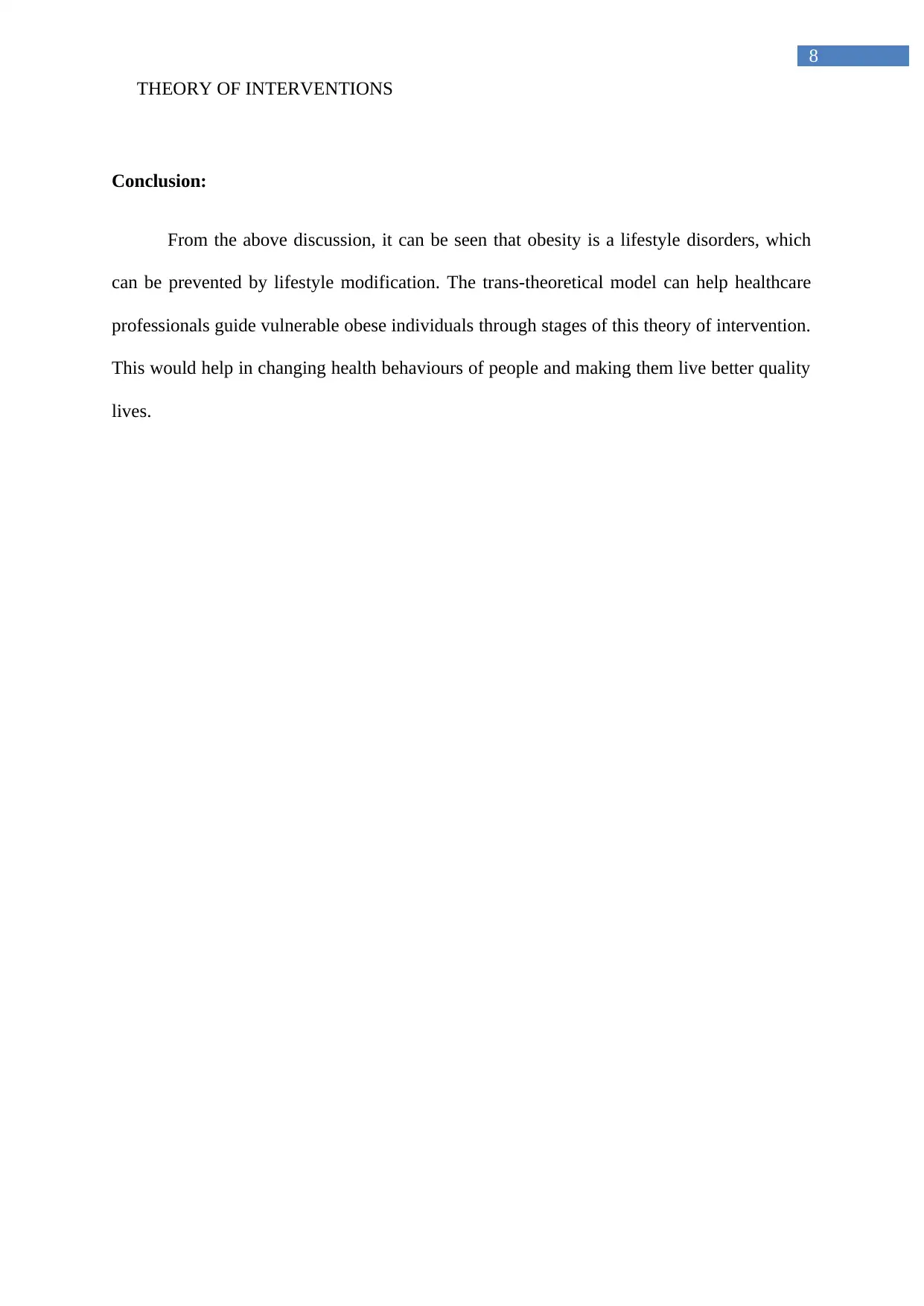
8
THEORY OF INTERVENTIONS
Conclusion:
From the above discussion, it can be seen that obesity is a lifestyle disorders, which
can be prevented by lifestyle modification. The trans-theoretical model can help healthcare
professionals guide vulnerable obese individuals through stages of this theory of intervention.
This would help in changing health behaviours of people and making them live better quality
lives.
THEORY OF INTERVENTIONS
Conclusion:
From the above discussion, it can be seen that obesity is a lifestyle disorders, which
can be prevented by lifestyle modification. The trans-theoretical model can help healthcare
professionals guide vulnerable obese individuals through stages of this theory of intervention.
This would help in changing health behaviours of people and making them live better quality
lives.
⊘ This is a preview!⊘
Do you want full access?
Subscribe today to unlock all pages.

Trusted by 1+ million students worldwide
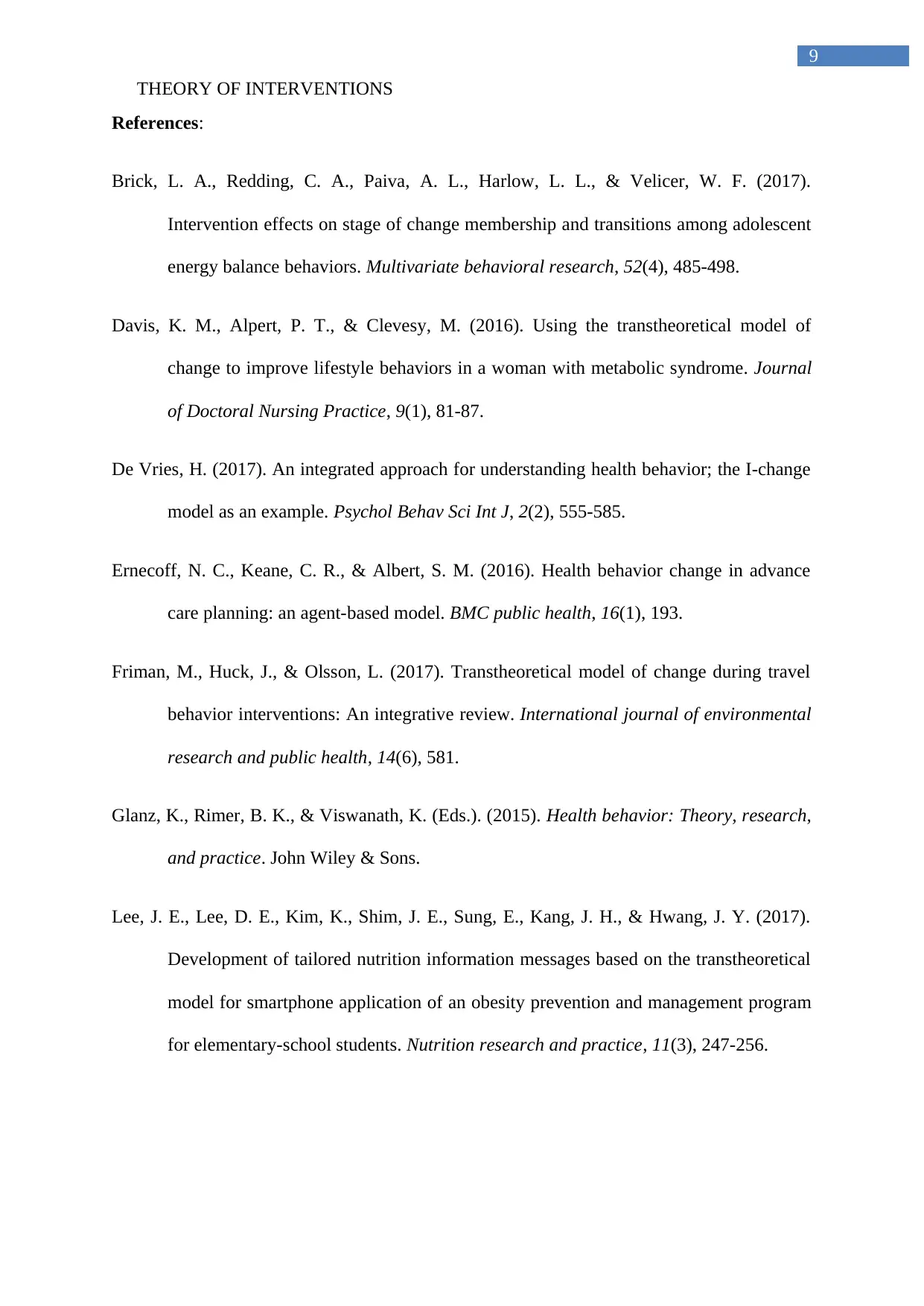
9
THEORY OF INTERVENTIONS
References:
Brick, L. A., Redding, C. A., Paiva, A. L., Harlow, L. L., & Velicer, W. F. (2017).
Intervention effects on stage of change membership and transitions among adolescent
energy balance behaviors. Multivariate behavioral research, 52(4), 485-498.
Davis, K. M., Alpert, P. T., & Clevesy, M. (2016). Using the transtheoretical model of
change to improve lifestyle behaviors in a woman with metabolic syndrome. Journal
of Doctoral Nursing Practice, 9(1), 81-87.
De Vries, H. (2017). An integrated approach for understanding health behavior; the I-change
model as an example. Psychol Behav Sci Int J, 2(2), 555-585.
Ernecoff, N. C., Keane, C. R., & Albert, S. M. (2016). Health behavior change in advance
care planning: an agent-based model. BMC public health, 16(1), 193.
Friman, M., Huck, J., & Olsson, L. (2017). Transtheoretical model of change during travel
behavior interventions: An integrative review. International journal of environmental
research and public health, 14(6), 581.
Glanz, K., Rimer, B. K., & Viswanath, K. (Eds.). (2015). Health behavior: Theory, research,
and practice. John Wiley & Sons.
Lee, J. E., Lee, D. E., Kim, K., Shim, J. E., Sung, E., Kang, J. H., & Hwang, J. Y. (2017).
Development of tailored nutrition information messages based on the transtheoretical
model for smartphone application of an obesity prevention and management program
for elementary-school students. Nutrition research and practice, 11(3), 247-256.
THEORY OF INTERVENTIONS
References:
Brick, L. A., Redding, C. A., Paiva, A. L., Harlow, L. L., & Velicer, W. F. (2017).
Intervention effects on stage of change membership and transitions among adolescent
energy balance behaviors. Multivariate behavioral research, 52(4), 485-498.
Davis, K. M., Alpert, P. T., & Clevesy, M. (2016). Using the transtheoretical model of
change to improve lifestyle behaviors in a woman with metabolic syndrome. Journal
of Doctoral Nursing Practice, 9(1), 81-87.
De Vries, H. (2017). An integrated approach for understanding health behavior; the I-change
model as an example. Psychol Behav Sci Int J, 2(2), 555-585.
Ernecoff, N. C., Keane, C. R., & Albert, S. M. (2016). Health behavior change in advance
care planning: an agent-based model. BMC public health, 16(1), 193.
Friman, M., Huck, J., & Olsson, L. (2017). Transtheoretical model of change during travel
behavior interventions: An integrative review. International journal of environmental
research and public health, 14(6), 581.
Glanz, K., Rimer, B. K., & Viswanath, K. (Eds.). (2015). Health behavior: Theory, research,
and practice. John Wiley & Sons.
Lee, J. E., Lee, D. E., Kim, K., Shim, J. E., Sung, E., Kang, J. H., & Hwang, J. Y. (2017).
Development of tailored nutrition information messages based on the transtheoretical
model for smartphone application of an obesity prevention and management program
for elementary-school students. Nutrition research and practice, 11(3), 247-256.
Paraphrase This Document
Need a fresh take? Get an instant paraphrase of this document with our AI Paraphraser
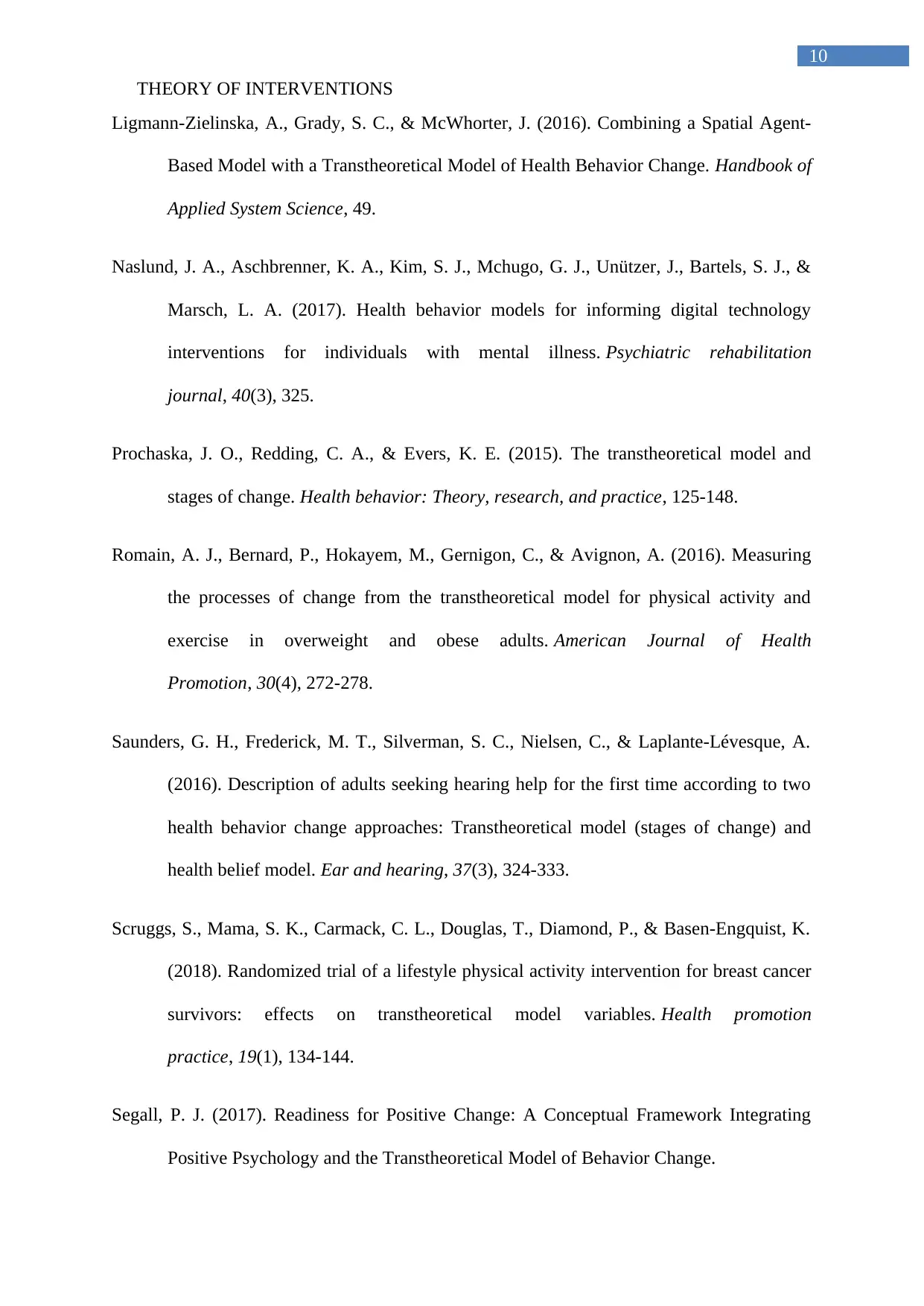
10
THEORY OF INTERVENTIONS
Ligmann-Zielinska, A., Grady, S. C., & McWhorter, J. (2016). Combining a Spatial Agent-
Based Model with a Transtheoretical Model of Health Behavior Change. Handbook of
Applied System Science, 49.
Naslund, J. A., Aschbrenner, K. A., Kim, S. J., Mchugo, G. J., Unützer, J., Bartels, S. J., &
Marsch, L. A. (2017). Health behavior models for informing digital technology
interventions for individuals with mental illness. Psychiatric rehabilitation
journal, 40(3), 325.
Prochaska, J. O., Redding, C. A., & Evers, K. E. (2015). The transtheoretical model and
stages of change. Health behavior: Theory, research, and practice, 125-148.
Romain, A. J., Bernard, P., Hokayem, M., Gernigon, C., & Avignon, A. (2016). Measuring
the processes of change from the transtheoretical model for physical activity and
exercise in overweight and obese adults. American Journal of Health
Promotion, 30(4), 272-278.
Saunders, G. H., Frederick, M. T., Silverman, S. C., Nielsen, C., & Laplante-Lévesque, A.
(2016). Description of adults seeking hearing help for the first time according to two
health behavior change approaches: Transtheoretical model (stages of change) and
health belief model. Ear and hearing, 37(3), 324-333.
Scruggs, S., Mama, S. K., Carmack, C. L., Douglas, T., Diamond, P., & Basen-Engquist, K.
(2018). Randomized trial of a lifestyle physical activity intervention for breast cancer
survivors: effects on transtheoretical model variables. Health promotion
practice, 19(1), 134-144.
Segall, P. J. (2017). Readiness for Positive Change: A Conceptual Framework Integrating
Positive Psychology and the Transtheoretical Model of Behavior Change.
THEORY OF INTERVENTIONS
Ligmann-Zielinska, A., Grady, S. C., & McWhorter, J. (2016). Combining a Spatial Agent-
Based Model with a Transtheoretical Model of Health Behavior Change. Handbook of
Applied System Science, 49.
Naslund, J. A., Aschbrenner, K. A., Kim, S. J., Mchugo, G. J., Unützer, J., Bartels, S. J., &
Marsch, L. A. (2017). Health behavior models for informing digital technology
interventions for individuals with mental illness. Psychiatric rehabilitation
journal, 40(3), 325.
Prochaska, J. O., Redding, C. A., & Evers, K. E. (2015). The transtheoretical model and
stages of change. Health behavior: Theory, research, and practice, 125-148.
Romain, A. J., Bernard, P., Hokayem, M., Gernigon, C., & Avignon, A. (2016). Measuring
the processes of change from the transtheoretical model for physical activity and
exercise in overweight and obese adults. American Journal of Health
Promotion, 30(4), 272-278.
Saunders, G. H., Frederick, M. T., Silverman, S. C., Nielsen, C., & Laplante-Lévesque, A.
(2016). Description of adults seeking hearing help for the first time according to two
health behavior change approaches: Transtheoretical model (stages of change) and
health belief model. Ear and hearing, 37(3), 324-333.
Scruggs, S., Mama, S. K., Carmack, C. L., Douglas, T., Diamond, P., & Basen-Engquist, K.
(2018). Randomized trial of a lifestyle physical activity intervention for breast cancer
survivors: effects on transtheoretical model variables. Health promotion
practice, 19(1), 134-144.
Segall, P. J. (2017). Readiness for Positive Change: A Conceptual Framework Integrating
Positive Psychology and the Transtheoretical Model of Behavior Change.
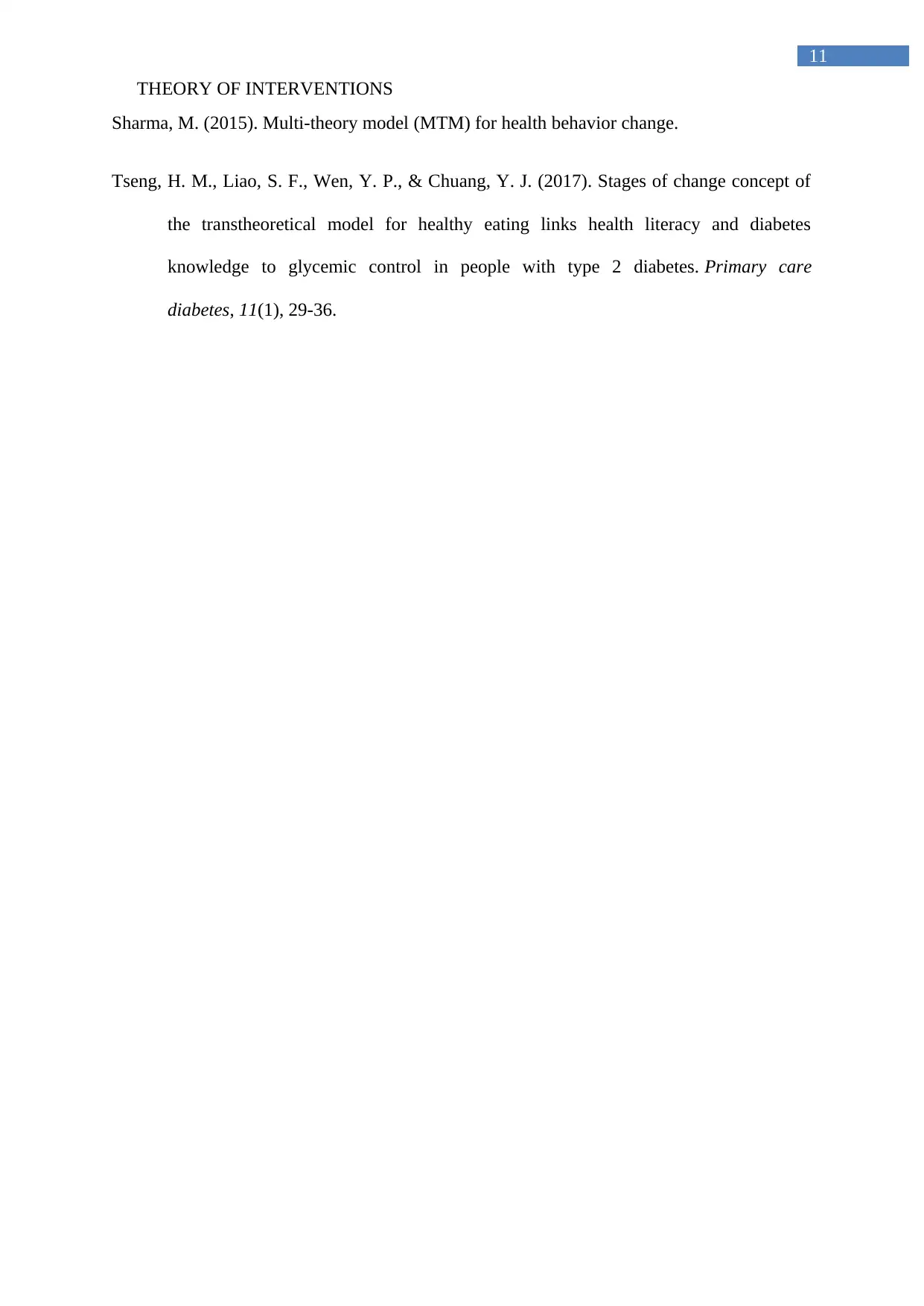
11
THEORY OF INTERVENTIONS
Sharma, M. (2015). Multi-theory model (MTM) for health behavior change.
Tseng, H. M., Liao, S. F., Wen, Y. P., & Chuang, Y. J. (2017). Stages of change concept of
the transtheoretical model for healthy eating links health literacy and diabetes
knowledge to glycemic control in people with type 2 diabetes. Primary care
diabetes, 11(1), 29-36.
THEORY OF INTERVENTIONS
Sharma, M. (2015). Multi-theory model (MTM) for health behavior change.
Tseng, H. M., Liao, S. F., Wen, Y. P., & Chuang, Y. J. (2017). Stages of change concept of
the transtheoretical model for healthy eating links health literacy and diabetes
knowledge to glycemic control in people with type 2 diabetes. Primary care
diabetes, 11(1), 29-36.
⊘ This is a preview!⊘
Do you want full access?
Subscribe today to unlock all pages.

Trusted by 1+ million students worldwide
1 out of 12
Related Documents
Your All-in-One AI-Powered Toolkit for Academic Success.
+13062052269
info@desklib.com
Available 24*7 on WhatsApp / Email
![[object Object]](/_next/static/media/star-bottom.7253800d.svg)
Unlock your academic potential
Copyright © 2020–2025 A2Z Services. All Rights Reserved. Developed and managed by ZUCOL.





